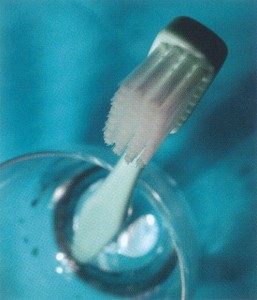
Dental plaque is a soft, sticky
substance that builds up on your
teeth. It is mostly made up of
bacteria, which feed on sugar
from food and drink, producing
acids as a waste product. The
acids attack the teeth by
dissolving the minerals in the
tooth surface. If this happens
too often, tooth decay results.
For this reason, you shouldn't
have sugary foods and / or drinks too often during the day.
Minerals in saliva can mend the teeth. If fluoride is present in the
mouth, it helps teeth to repair themselves. Fluoride also makes
bacteria less able to produce acid.
To remove plaque and help teeth to mend themselves, you need to
brush twice a day with a fluoride toothpaste.
You also need to brush to stop plaque damaging your gums. If plaque is allowed to build up, the bacteria in it can make your gums sore and infected. Painless gum 'pockets' will start to form around the teeth - and bone supporting the teeth will slowly be lost. If left unchecked, gum disease will lead to the loss of teeth.
© Stalybridge Dental Care 2009 - 2024
Last updated: 28 November 2023